Themed collection Non-Fullerene Acceptors for Organic Solar Cells

Non-fullerene acceptors inaugurating a new era of organic photovoltaic research and technology
Guest editors Xiaowei Zhan and Seth Marder introduce this Materials Chemistry Frontiers themed collection on non-fullerene acceptors for organic solar cells.

Mater. Chem. Front., 2019,3, 180-180
https://doi.org/10.1039/C9QM90005E
The crucial role of end group planarity for fused-ring electron acceptors in organic solar cells
Planar acceptor moieties in FREAs are necessary, as expanding the π–π stacking by only 1 Å disrupts the packing and decreases performance.

Mater. Chem. Front., 2019,3, 1642-1652
https://doi.org/10.1039/C9QM00314B
Highly-efficient semi-transparent organic solar cells utilising non-fullerene acceptors with optimised multilayer MoO3/Ag/MoO3 electrodes
We report the optimisation of a semi-transparent solar cell based on a blend of a recently reported high performance donor polymer (PFBDB-T) with a non-fullerene acceptor derivative (C8-ITIC).
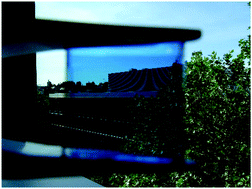
Mater. Chem. Front., 2019,3, 450-455
https://doi.org/10.1039/C8QM00610E
Pairing 1D/2D-conjugation donors/acceptors towards high-performance organic solar cells
1D conjugated donor FTAZ, 2D conjugated donor J71, 1D conjugated acceptor ITIC1, and 2D conjugated acceptor ITIC2 were used to investigate the effects of conjugation dimension on the performance of organic solar cells.
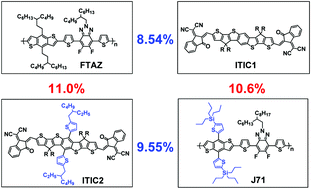
Mater. Chem. Front., 2019,3, 276-283
https://doi.org/10.1039/C8QM00512E
Multi-length scale morphology of nonfullerene all-small molecule blends and its relation to device function in organic solar cells
Device characteristics of a pair of nonfullerene small molecule solar cells were well correlated to their mesoscale morphology via resonant soft X-ray scattering.
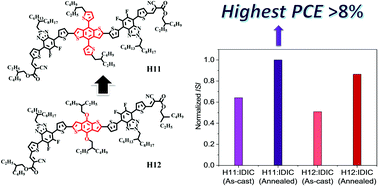
Mater. Chem. Front., 2019,3, 137-144
https://doi.org/10.1039/C8QM00503F
Pyrene-fused PDI based ternary solar cells: high power conversion efficiency over 10%, and improved device thermal stability
A class of pyrene-fused PDI-NFAs are designed and synthesized for fabricating ternary OSC devices to improve the absorption in the short wavelength region, VOC and thermal stability of the ternary devices.

Mater. Chem. Front., 2019,3, 93-102
https://doi.org/10.1039/C8QM00486B
Combination of noncovalent conformational locks and side chain engineering to tune the crystallinity of nonfullerene acceptors for high-performance P3HT based organic solar cells
The performances of P3HT based OSCs were systematically improved attributed to the modification of the side chains of small molecules.
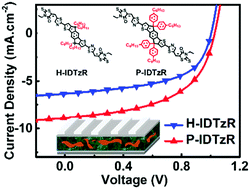
Mater. Chem. Front., 2019,3, 64-69
https://doi.org/10.1039/C8QM00461G
An A–D–A′–D–A type small molecule acceptor with wide absorption spectrum and near-infrared absorption
We report a new A–D–A′–D–A type small molecule acceptor with a wide absorption spectrum spanning from 300 nm to 900 nm and a bandgap of only 1.39 eV.

Mater. Chem. Front., 2018,2, 2333-2339
https://doi.org/10.1039/C8QM00441B
Enhancement of intra- and inter-molecular π-conjugated effects for a non-fullerene acceptor to achieve high-efficiency organic solar cells with an extended photoresponse range and optimized morphology
The extended π-conjugation of DF-PCNC leads to higher PCE and JSC for the resultant OSCs.

Mater. Chem. Front., 2018,2, 2006-2012
https://doi.org/10.1039/C8QM00318A
A novel bifunctional A–D–A type small molecule for efficient organic solar cells
A novel A–D–A type small molecule named DTFBR was designed and synthesized. DTFBR exhibited bifunctional properties when combined with different photovoltaic materials.
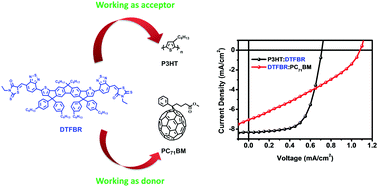
Mater. Chem. Front., 2018,2, 1626-1630
https://doi.org/10.1039/C8QM00223A
Understanding the influence of carboxylate substitution on the property of high-performance donor polymers in non-fullerene organic solar cells
Carboxylate substitution can enhance crystallinity and introduce purer domains; alkyl chains provide a temperature-dependent aggregation property.

Mater. Chem. Front., 2018,2, 1360-1365
https://doi.org/10.1039/C8QM00101D
About this collection
Although fullerene derivatives have been the most widely used electron acceptors in organic solar cells (OSCs) during the last two decades, they suffer from some shortcomings, such as weak light absorption, limited variability of energy levels, and poor morphology stability, constraining the sustainable development of this field. Since 2015, there have been breakthroughs in non-fullerene acceptors, and device efficiency has rapidly increased from ‹6% to ›14%, outperforming that of fullerene acceptors. The emergence of high-performance non-fullerene acceptors has overturned predominant position of fullerene acceptors and is inaugurating the new era of OSCs.
Guest edited by Xiaowei Zhan (Peking University) and Seth Marder (Georgia Tech), this themed collection intends to publish some selected works in the field of non-fullerene OSCs and to demonstrate the latest research advances on this hot topic.
More articles will be added as soon as they are published.